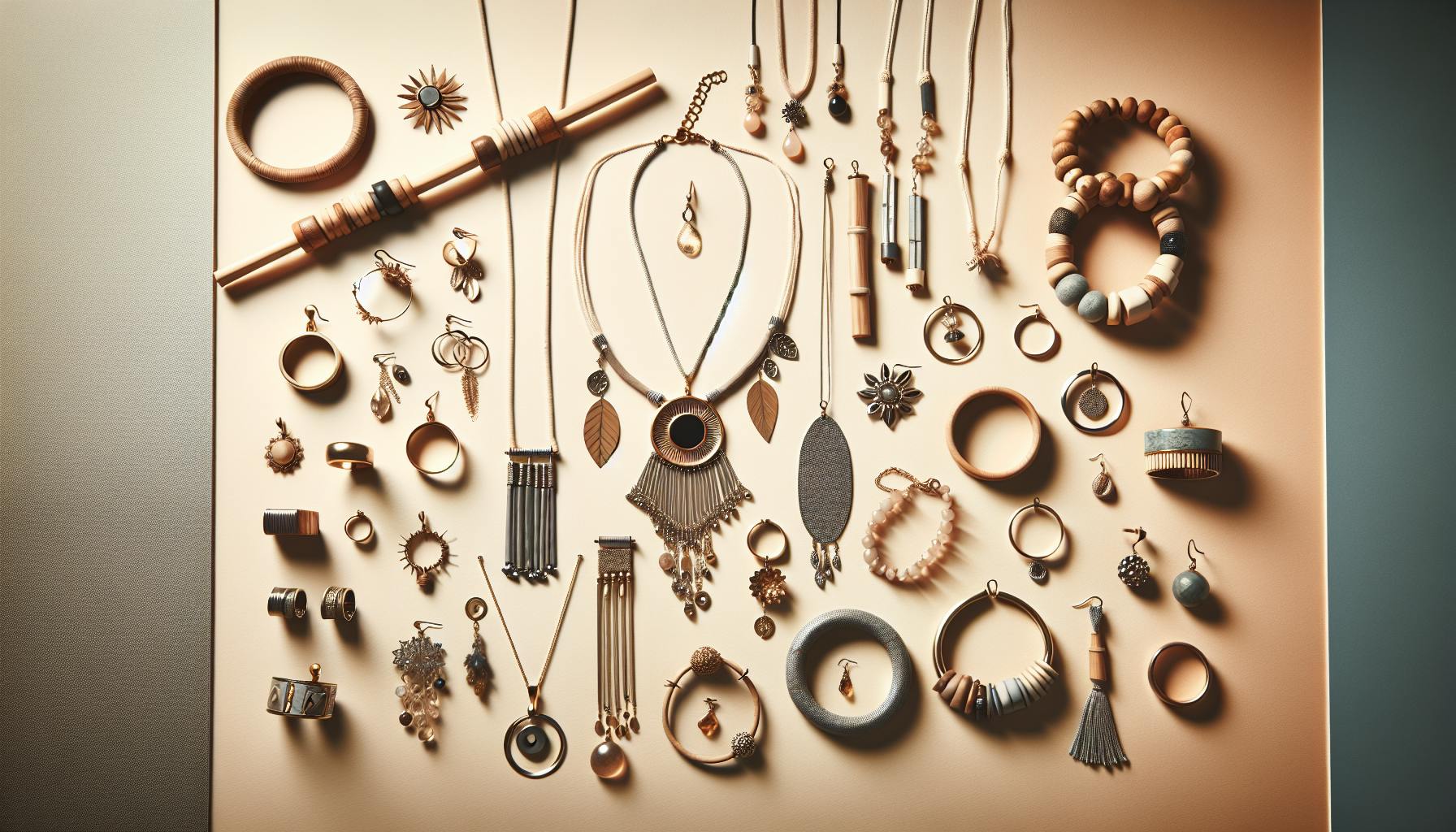28th Jan 2024
Green is the New Bling: Exploring the World of Environmentally Friendly Jewellery
The Growing Trend of Environmentally Friendly Jewellery
In recent years, the fashion industry has experienced a shift towards more sustainable and ethical practices. One notable trend is the rise of environmentally friendly jewellery. This new wave of adornments is not only stylish but also kind to our planet.
Understanding the Concept of Environmentally Friendly Jewellery
Environmentally friendly jewellery, also known as eco-conscious or sustainable jewellery, takes into account both the planet and people during its production process. It involves the use of ethically-sourced materials, sustainable production methods, and often incorporates recycled or upcycled elements.
For instance, recycled jewellery uses materials that have been previously used, such as metals from old jewellery or electronic waste. On the other hand, organic jewellery uses materials that are biodegradable and sourced from nature, like wood, shells, or plant-based resins.
Why Environmentally Friendly Jewellery Matters
The importance of environmentally friendly jewellery can't be overstated. Traditional jewellery production often involves practices that can be harmful to the environment, such as mining for precious metals and gemstones. These processes can lead to habitat destruction, soil erosion, and water contamination.
Furthermore, traditional jewellery production can also involve unethical practices, such as unfair labour conditions and human rights violations. Therefore, by choosing environmentally friendly jewellery, consumers are not only helping to protect the planet but also promoting fair trade and ethical labour practices. If you're interested, you can learn more about fair trade jewellery here.
By purchasing environmentally friendly jewellery, you're also supporting innovative practices in the jewellery industry. For instance, you could be helping a designer who's creating beautiful pieces from recycled glass or a company that's pioneering the use of lab-grown diamonds.
In summary, the trend of environmentally friendly jewellery is more than just a fashion statement. It's a way for consumers to express their style while making a positive impact on the world. As the demand for eco-friendly accessories continues to grow, it's clear that this is more than just a trend – it's the future of jewellery.

The Impact of Traditional Jewellery Production
While traditional jewellery might hold aesthetic and sentimental value, it's worth contemplating the impact of its production on the planet and its inhabitants. This section will delve into the environmental concerns and social and ethical issues associated with conventional jewellery production.
Environmental Concerns
One of the primary environmental concerns related to traditional jewellery production is the mining of precious metals and gemstones. Mining activities can lead to deforestation, soil erosion, and contamination of water sources due to the use of harmful chemicals. For instance, the extraction of one gold ring can result in approximately 20 tonnes of waste, much of which is toxic.
| Material | Waste Produced |
|---|---|
| Gold (for one ring) | 20 tonnes |
| Silver (per ounce) | 10 tonnes |
Moreover, the energy-intensive nature of mining and refining processes contributes significantly to greenhouse gas emissions. Therefore, shifting towards environmentally friendly jewellery, such as recycled metal jewellery or recycled glass jewellery, can help alleviate these environmental pressures.
Social and Ethical Issues
Beyond the environmental considerations, traditional jewellery production also raises serious social and ethical concerns. In many parts of the world, the jewellery supply chain is tainted by poor working conditions, child labour, and unfair wages. Additionally, the industry often supports conflict regions by purchasing "blood diamonds" or conflict minerals, which are mined in war-torn areas under brutal conditions.
Furthermore, the rights of indigenous communities are often overlooked in the pursuit of precious materials. Land rights are violated, and local communities are displaced to make way for mining operations without fair compensation.
As consumers become more aware of these issues, many are turning to ethical jewellery options, including fair trade jewellery and pieces made from upcycled accessories.
In conclusion, the traditional jewellery industry's impact on the environment and society underscores the need for more sustainable and ethical practices. By choosing environmentally friendly jewellery, consumers can play a role in mitigating these issues and promoting a more sustainable future for the industry.
Elements of Environmentally Friendly Jewellery
Making a shift towards environmentally friendly jewellery involves multiple aspects, from sourcing materials to the production process and the use of recycled elements. Here, we explore these essential components of eco-conscious jewellery.
Ethically Sourced Materials
Environmentally friendly jewellery starts with ethically sourced materials. These include gemstones and metals that are extracted in a manner that minimises environmental damage and ensures fair treatment of workers. This approach often involves compliance with fair trade principles, ensuring that miners receive a decent wage and work in safe conditions. For more insights, visit our post on fair trade jewellery.
Additionally, ethically sourced materials may also include organic materials that are harvested sustainably, without damaging ecosystems or causing species depletion. Organic materials can range from wood and bamboo to natural fibres. Check out our organic jewellery article for more information.
Sustainable Production Practices
An integral aspect of environmentally friendly jewellery is sustainable production practices. This involves processes that minimise waste, energy consumption, and harmful emissions. It also encompasses practices that prioritise the welfare of the workforce and the community surrounding the production facilities.
In the realm of sustainable production, advanced technologies and innovative techniques are continually being developed. These innovations are helping to reduce the environmental footprint of jewellery production, earning the moniker of sustainable jewellery.
Recycled and Upcycled Elements
The use of recycled and upcycled elements is another key characteristic of environmentally friendly jewellery. This involves the use of previously used metals and gemstones, as well as the creative repurposing of non-traditional materials.
Recycled jewellery, such as recycled metal jewellery and recycled glass jewellery, involves the reprocessing of materials to create new pieces. This approach helps to reduce the need for new mining and the associated environmental impact.
On the other hand, upcycled jewellery involves the creative transformation of discarded or leftover materials into unique pieces of jewellery. This includes everything from old watch parts to discarded beads and buttons. For more on this, see our article on upcycled accessories.
By considering these elements, individuals can make more informed decisions when seeking out environmentally friendly jewellery. Each aspect, from ethically sourced materials to sustainable production practices and the use of recycled and upcycled elements, contributes to the overall environmental impact of the jewellery piece. Thus, each choice made in favour of eco-conscious jewellery helps to support a more sustainable and ethical fashion industry.
![]()
Different Types of Environmentally Friendly Jewellery
In the realm of eco-conscious jewellery, a variety of sustainable alternatives are emerging, each with its unique appeal and environmental benefits. Let's delve into three prevalent types of environmentally friendly jewellery: Eco-Gold and Eco-Silver Jewellery, Lab-Grown Gemstone Jewellery, and Upcycled and Recycled Jewellery.
Eco-Gold and Eco-Silver Jewellery
Eco-gold and eco-silver jewellery are created using precious metals that have been sourced responsibly. These metals come from mines that adhere to stringent environmental and ethical standards, ensuring minimal harm to the environment and fair treatment of workers.
Eco-gold and eco-silver offer the same quality and aesthetic appeal as traditionally sourced precious metals, making them a popular choice for environmentally conscious jewellery enthusiasts. Choosing eco-gold and eco-silver jewellery supports sustainable mining practices and promotes a more ethical jewellery industry.
Lab-Grown Gemstone Jewellery
Lab-grown gemstone jewellery is another excellent alternative for those seeking environmentally friendly jewellery options. These gemstones are grown in a lab under controlled conditions, replicating the natural processes that form gemstones over millions of years.
Lab-grown gemstones have the same physical, chemical, and optical properties as naturally mined gemstones, making them a high-quality and sustainable alternative. By choosing lab-grown gemstone jewellery, consumers can enjoy the beauty of precious gemstones without contributing to the environmental and social issues associated with traditional gemstone mining.
Upcycled and Recycled Jewellery
Upcycled and recycled jewellery is created using materials that have been repurposed or reused. This could include everything from recycled metal jewellery to pieces made from recycled glass jewellery.
Upcycled jewellery often involves creatively repurposing items into unique and beautiful pieces of jewellery. On the other hand, recycled jewellery typically involves melting down metals or reforming materials to create new pieces. Both types of jewellery help reduce waste and conserve natural resources, making them an excellent choice for those committed to sustainable fashion.
These are just a few examples of the different types of environmentally friendly jewellery available. By supporting these sustainable jewellery options, consumers can help drive demand for more responsible practices in the jewellery industry. As we continue to explore and innovate, the future of sustainable jewellery looks brighter than ever.
The Future of Environmentally Friendly Jewellery
In the ever-evolving world of fashion, the future of environmentally friendly jewellery looks promising. With rapid innovations in sustainable production and a growing demand from eco-conscious consumers, the industry is poised for significant transformation.
Innovations in Sustainable Jewellery Production
Increasingly, advancements in technology and design are paving the way for more sustainable production practices in the jewellery industry. From the use of lab-grown gemstones to innovative recycling techniques, these developments are helping to reduce the environmental footprint of jewellery production.
A key innovation in sustainable jewellery production has been the advent of lab-grown gemstones. These gems, cultivated in controlled environments, offer a more sustainable alternative to traditionally mined stones. They possess the same physical and aesthetic properties as their natural counterparts but are produced without the extensive environmental degradation associated with mining.
Another promising development is the rise of recycled jewellery. Through ingenious techniques, discarded materials such as metals, glass, and even plastic can be transformed into stunning pieces of jewellery. This not only reduces waste but also curbs the demand for new resources.
Furthermore, sustainable energy sources are being increasingly integrated into jewellery production processes. This includes the use of solar power in workshops and water-saving techniques in gem cutting and polishing, further reducing the industry's environmental impact.
Role of Consumer Demand in Shaping the Industry
As much as technological and design innovations are driving change within the jewellery industry, consumer behaviour and preferences play an equally crucial role. A growing number of consumers are becoming more conscious of the environmental and social impact of their purchases, leading to increased demand for environmentally friendly jewellery.
This shift in consumer behaviour is not only encouraging established jewellery brands to adopt more sustainable practices but is also leading to the emergence of new brands dedicated to producing ethical and eco-friendly jewellery. This trend is expected to continue, with consumers increasingly favouring brands that align with their values of sustainability and ethical consumption.
The demand for transparency is also shaping the industry. Consumers want to know where their jewellery comes from, the materials used, and the impact of their production. This has led to more brands adopting traceability practices, providing customers with information about the sourcing and production of their jewellery.
The future of environmentally friendly jewellery is dynamic and evolving, driven by both innovative sustainable practices and changing consumer behaviour. As we move forward, the synergy of these elements will continue to pave the way towards a more sustainable and ethical jewellery industry. For those interested in exploring this world further, our articles on fair trade jewellery, organic jewellery, ethical jewellery, and upcycled accessories provide more insights.

